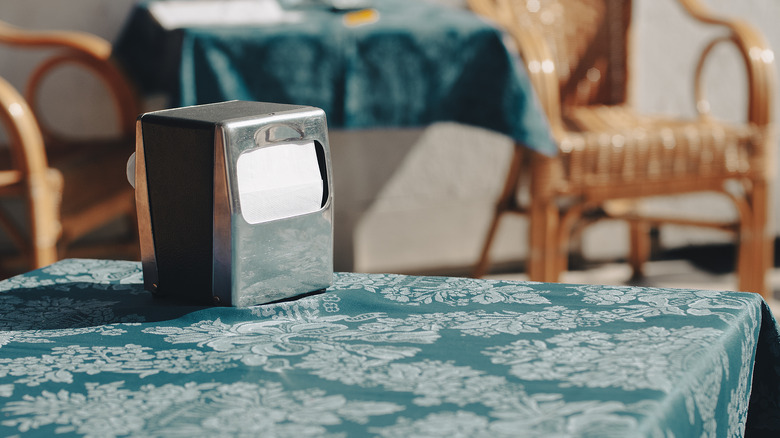Those 'Napkin Dispensers' At Cafes In Italy Aren't What You Think They Are
If you've ever visited a café or what is commonly called a "bar" in Italy, you may have noticed a small, unassuming box on the counter or tables filled with thin sheets of paper. At first glance, you might think, "Oh, great! Some napkins to clean up the mess I made with this croissant." Alas, if you've ever actually tried to use one to dry a spill or wipe your hands, you likely discovered that these so-called "napkins" aren't exactly what you expected.
@trippingmillennial We truly cannot be the only ones who were thrown by this... 🤦♀️ #italytips #italiancafe #traveltips
In fact, those thin, waxy, transparent, rough, 1/8th-ply sheets aren't napkins at all, at least not in the way most people outside of Italy think of napkins. These are called tovagliolini, which translates to "little napkins." They are found all over Italy in cafés, bars, and pastry shops ("pasticceria" in Italian). Unlike the larger, more plush, and absorbent napkins many people are accustomed to, these are small, thin, slippery, and do not absorb drops, crumbs, or anything, really.
Their primary function is not to clean up messes or to be used as a handkerchief, but to serve as a sanitary barrier between your fingers and the food you're eating, particularly sticky, sugary pastries and small snacks. In local Italian coffee culture, it's common to enjoy a cappuccino (only before 11 a.m. — don't make this embarrassing cappuccino mistake) with a cornetto (an Italian croissant). The tovagliolini are only meant to handle these treats, allowing you to enjoy your food without directly touching it with your hands.
Tovagliolini: Why they're not like regular napkins
Why is tovagliolini even a thing? First, they are cheaper for the establishment to stock and customize with their logo. Second, although their intended use can only be described as "deceptive," this not-napkin "napkin" actually does what it's designed to do. Because it's made with a waxy finish and pure cellulose, the glaze, sugar, grease, or whatever sticky topping you have on your food doesn't stick to the tovagliolini. On the other hand, regular napkins stick to food, and you end up with bits of tissue in your mouth — no, grazie. So, the tovagliolini design does reflect its intended use: small, lightweight, and perfect for wrapping around a pastry or holding a slice of Neapolitan pizza (which, unfortunately, makes them impractical for anything else).
For travelers unfamiliar with local Italian café culture, discovering these non-traditional napkins can be a bit of a surprise. However, understanding their purpose and embracing them for what they are, and not what you want them to be, will be a game-changer on your Italian journey. Don't pull out 15 tovagliolini to wipe your hands after a melted gelato; it will not work, and you will be disappointed. If you find yourself in need of a more old-fashioned napkin, don't hesitate to ask the staff. Otherwise, carry a small pack of wet wipes or standard, absorbent napkins. But for those quick bites and morning espressos, the humble tovagliolini — after some getting used to — will likely be all you need.

